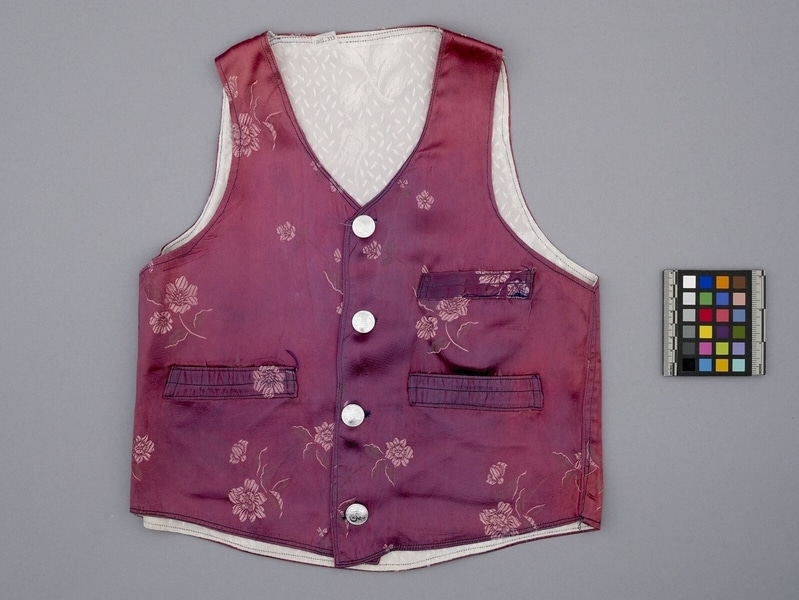Boy's Vest Item Number: Ed1.333 from the MOA: University of British Columbia


Description
Vest fastening in the centre front with four silver coloured buttons, made of plum coloured silk satin with a pattern of flowers. On the front there is an inset pocket with an outside facing at each side, and on the left side above the pocket is a third, smaller pocket. The vest is lined with white fabric woven in an overall pattern of small leaves with a bolder pattern of larger leaves. Each silver button has a Chinese character on an embossed background. There is a double line of machine stitching along the lower edge, which curves downward to the centre front.
History Of Use
Vests in western style began to be widely used in the 1930s, when they became popular. This reflected western influence in Korea after the opening of Korea to the outside world in the late 19th century. Before the 1930s, boys wore longer sleeveless vests called “Bae-ja”, which fastened with a cord at underarm level and tied at the centre front. The pockets and buttons also reflect western influence, the pockets replacing the pouches formerly used to carry small items and the buttons replacing the ribbon ties formerly used. Vests with lower edges curving downwards to the centre front retain this traditional Korean feature, however. Vests worn by men have five buttons, while boys’ vests have four.
Specific Techniques
The vest is made with machine stitching except for the button holes, which are sewn by hand. The right underarm seam was the last one sewn. The final finishing stitches were those along the bottom edge.
Iconographic Meaning
The fine fabric indicates that this vest was to be worn on special occasions.
Narrative
Worn by Mark Elrod as a boy, while living with his family in Korea. Most of the clothing in the J. McRee Elrod Collection was made for him and his family by friends while they were living in Korea, much of it by Kim, Sung Sook. She and her family lived cooperatively in the same house as the Elrod family. While they were there, the Elrods preferred to wear Korean clothing on very cold days and for social occasions. They found it to be more comfortable than western clothing in cold weather, as public buildings were unheated in the period immediately following the Korean War. It also was more comfortable for floor seating in Korean homes, and easier to store with limited furniture than western clothing. The children’s clothing was worn by their children.
Item History
- Made by Sung Sook Kim (Maker) in Seoul, Korea between 1955 and 1960
- Collected between 1955 and 1960
- Owned by Mark Elrod
- Owned by J. McRee Elrod before October 13, 1976
- Received from J. McRee Elrod (Donor) on October 13, 1976
What
- Name
- Boy's Vest
- Identification Number
- Ed1.333
- Type of Item
- vest
- Material
- silk fibre, rayon fibre, metal and dye
- Manufacturing Technique
- spun, dyed, woven and sewn
- Overall
- height 42.5 cm, width 37.0 cm
Who
- Culture
- Korean
- Creator
- Sung Sook Kim (Maker)
- Previous Owner
- Mark Elrod and J. McRee Elrod
- Received from
- J. McRee Elrod (Donor)
Where
- Holding Institution
- MOA: University of British Columbia
- Made in
- Seoul, Korea
When
- Creation Date
- between 1955 and 1960
- Collection Date
- between 1955 and 1960
- Ownership Date
- before October 13, 1976
- Acquisition Date
- on October 13, 1976
Other
- Item Classes
- textiles
- Condition
- good
- Accession Number
- 0335/0014